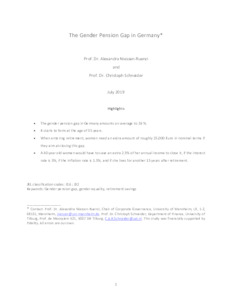|
The gender pension gap in Germany
Niessen-Ruenzi, Alexandra
;
Schneider, Christoph
![[img]](https://madoc.bib.uni-mannheim.de/52122/1.hassmallThumbnailVersion/Gender%20Pension%20Gap%20in%20Germany%20update%20-%20NiessenRuenziSchneider.pdf)  Vorschau |
|
PDF
Gender Pension Gap in Germany update - NiessenRuenziSchneider.pdf
- Veröffentlichte Version
Download (350kB)
|
|
URL:
|
https://madoc.bib.uni-mannheim.de/52122
|
|
URN:
|
urn:nbn:de:bsz:180-madoc-521226
|
|
Dokumenttyp:
|
Arbeitspapier
|
|
Erscheinungsjahr:
|
2019
|
|
Ort der Veröffentlichung:
|
Mannheim ; Tilburg
|
|
Sprache der Veröffentlichung:
|
Englisch
|
|
Einrichtung:
|
Fakultät für Betriebswirtschaftslehre > Business Administration and Corporate Governance (Stiftungsprofessur)
|
|
Fachgebiet:
|
330 Wirtschaft
|
|
Freie Schlagwörter (Deutsch):
|
Rentenlücke
|
|
Freie Schlagwörter (Englisch):
|
Pension Gap
|
|
Abstract:
|
In this short study, we quantify the gender pension gap in Germany and examine how much more women would have to save for retirement to close it. The gender pension gap is first computed as an average across all employees and then split up into various age cohorts and occupations.
Based on a broad database on wage income obtained from the Institute of Employment Research (IAB), to which all German businesses have to report, we estimate each employee’s statutory pension entitlements and find that the gender pension gap in Germany amounts on average to 26 %. While we do not observe a significant gender pension gap for employees below 35 years of age, the gender pension gap gets larger for older age cohorts. We argue that the decision to start a family is the most likely explanation for this pattern. As female labor force participation reduces drastically after giving birth, and never fully recuperates, labor income decreases and so do stat-utory pension entitlements of women.
The gender pension gap is lower, and sometimes even negative for occupations where salaries are heavily regulated (for example, municipal clerks) and for occupations that are predominantly performed by women (for example, child care workers). It increases for occupations where sala-ries depend more on employees’ negotiation skills.
We also compute how the gender pension gap can be closed, i.e., how much more women would have to save to make sure that they have the same pension payments (supplemented by their savings) than men upon retirement. We find that in most cases, the additional savings amount needed makes only up for a small fraction of women’s annual income, ranging between 1-2% for most age groups and occupations.
|
 | Dieser Eintrag ist Teil der Universitätsbibliographie. |
 | Das Dokument wird vom Publikationsserver der Universitätsbibliothek Mannheim bereitgestellt. |
 Suche Autoren in Suche Autoren in
Sie haben einen Fehler gefunden? Teilen Sie uns Ihren Korrekturwunsch bitte hier mit: E-Mail
Actions (login required)
 |
Eintrag anzeigen |
|
|
 ORCID: 0000-0002-9493-8280 ; Schneider, Christoph
ORCID: 0000-0002-9493-8280 ; Schneider, Christoph






 Suche Autoren in
Suche Autoren in